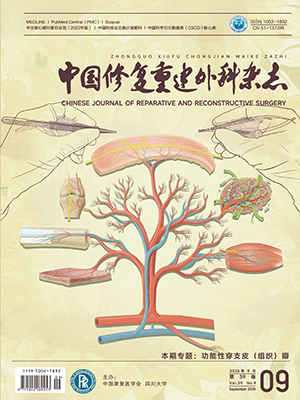| 1. |
Sherling N, Yilmaz M, Holm CE, et al. Validity of the Musculoskeletal Tumor Society Score for lower extremity in patients with bone sarcoma or giant cell tumour of bone undergoing bone resection and reconstruction surgery in hip and knee. BMC Cancer, 2024, 24(1): 1019. doi: 10.1186/s12885-024-12686-9.
|
| 2. |
Uehara K, Ogura K, Akiyama T, et al. Reliability and validity of the Musculoskeletal Tumor Society Scoring System for the upper extremity in Japanese patients. Clin Orthop Relat Res, 2017, 475(9): 2253-2259.
|
| 3. |
Rizzo A, Paderno M, Saccomanno MF, et al. The Musculoskeletal Tumor Society Scoring System is a valid subjective and objective tool to evaluate outcomes of surgical treatment of patients affected by upper and lower extremity tumors. Musculoskelet Surg, 2024, 108(2): 201-214.
|
| 4. |
Iwata S, Uehara K, Ogura K, et al. Reliability and validity of a Japanese-language and culturally adapted version of the Musculoskeletal Tumor Society Scoring System for the lower extremity. Clin Orthop Relat Res, 2016, 474(9): 2044-2052.
|
| 5. |
Khal AA, Apostu D, Cosnarovici R, et al. Cross-cultural adaptation and validation of the Romanian Musculoskeletal Tumor Society Scoring System for patients with extremity bone sarcomas. Medicina (Kaunas), 2024, 60(5): 778. doi: 10.3390/medicina60050778.
|
| 6. |
Kim HS, Yun J, Kang S, et al. Cross-cultural adaptation and validation of the Korean Toronto Extremity Salvage Score for extremity sarcoma. J Surg Oncol, 2015, 112(1): 93-97.
|
| 7. |
Lonjon G, Porcher R, Ergina P, et al. Potential pitfalls of reporting and bias in observational studies with propensity score analysis assessing a surgical procedure: a methodological systematic review. Ann Surg, 2017, 265(5): 901-909.
|
| 8. |
Schober P, Boer C, Schwarte LA. Correlation coefficients: Appropriate use and interpretation. Anesth Analg, 2018, 126(5): 1763-1768.
|
| 9. |
Bergh DVD, Wagenmakers E, Aust F. Bayesian repeated-measures analysis of variance: An updated methodology implemented in JASP. Advances in Methods and Practices in Psychological Science, 2023. doi:10.1177/25152459231168024.
|
| 10. |
Gromisch ES, Turner AP, Neto LO, et al. Establishing the test-retest reliability and minimal detectable change of the multiple sclerosis resiliency scale. Int J MS Care, 2023, 25(1): 15-19.
|
| 11. |
Miller TA, Campbell JH, England DL, et al. OASIS 2: Mobility differences with specific prosthetic feet across procedure codes. J Rehabil Assist Technol Eng, 2022, 9: 20556683221101623. doi: 10.1177/20556683221101623.
|
| 12. |
Bae TS, Choi K, Hong D, et al. Dynamic analysis of above-knee amputee gait. Clin Biomech (Bristol), 2007, 22(5): 557-566.
|
| 13. |
Amma R, Hisano G, Murata H, et al. Inter-limb weight transfer strategy during walking after unilateral transfemoral amputation. Sci Rep, 2021, 11(1): 4793. doi: 10.1038/s41598-021-84357-9.
|
| 14. |
Sanderson DJ, Martin PE. Lower extremity kinematic and kinetic adaptations in unilateral below-knee amputees during walking. Gait & Posture, 1997, 6(2): 126-136.
|
| 15. |
Kowal M, Winiarski S, Gieysztor E, et al. Symmetry function in gait pattern analysis in patients after unilateral transfemoral amputation using a mechanical or microprocessor prosthetic knee. J Neuroeng Rehabil, 2021, 18(1): 9. doi: 10.1186/s12984-021-00810-w.
|
| 16. |
Uwamahoro R, Sundaraj K, Subramaniam ID. Assessment of muscle activity using electrical stimulation and mechanomyography: a systematic review. Biomed Eng Online, 2021, 20(1): 1. doi: 10.1186/s12938-020-00840-w.
|
| 17. |
Jin Y, Alvarez JT, Suitor EL, et al. Estimation of joint torque in dynamic activities using wearable A-mode ultrasound. Nat Commun, 2024, 15(1): 5756. doi: 10.1038/s41467-024-50038-0.
|
| 18. |
Sousa MV, Goethel M, Becker KM, et al. Effect of experimentally induced muscle pain on neuromuscular control of force production. Hum Mov Sci, 2024, 95: 103219. doi: 10.1016/j.humov.2024.103219.
|




